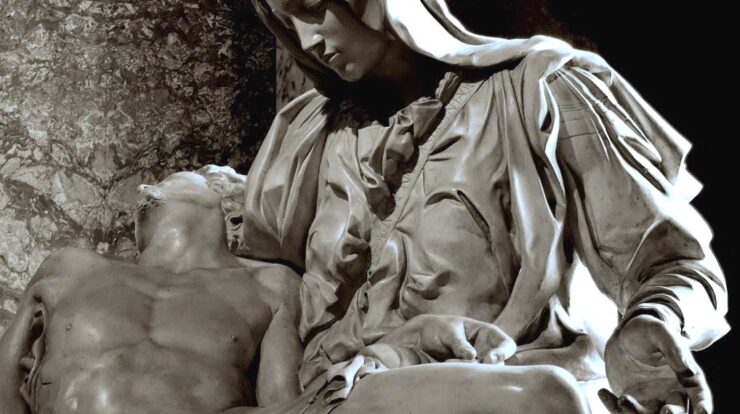
When I think about the sculptures that have stopped me in my tracks—even just in photos—Michelangelo’s Pietà always comes to mind.
Carved between 1498 and 1499 for St. Peter’s Basilica, the Pietà shows the Virgin Mary holding the body of Christ after the crucifixion. It’s a familiar subject, but what Michelangelo did with it was something new. He brought grace, restraint, and astonishing realism to a scene that could have easily veered into melodrama.
What’s even more incredible? He was just 23 years old.
Mary’s youthful face, serene expression, and the way she gently supports Jesus—it’s emotionally quiet, but that’s what makes it powerful. The folds of her robe seem to ripple like fabric, and Christ’s body, though lifeless, still radiates peace.
One detail that’s always fascinated me: this is the only work Michelangelo ever signed. According to legend, after hearing someone else credited for the sculpture, he returned and carved his name across Mary’s sash. It’s a bold move for a young artist—but also a testament to how deeply he knew what he had created.
You can already see in the Pietà the ideas that would shape Michelangelo’s career—his love of the human form, his merging of physical beauty and spiritual meaning. Themes he’d revisit in the David, and again on the ceiling of the Sistine Chapel.
If you’re interested in digging deeper into his life, I highly recommend two books:
-
The Agony and the Ecstasy by Irving Stone (a rich, fictional retelling)
-
Michelangelo and the Pope’s Ceiling by Ross King (a historical deep dive into the Sistine project)
(The above are affiliate links)
Each captures something essential about the master and his relentless drive to create.
Now I’d love to hear from you:
Have you ever seen the Pietà in person?
What details or emotions stand out to you when you look at it?
Leave a comment below—I’d love to continue the conversation.
Upon entering St. Peter’s Basilica, I turned right and saw the Pieta and it stopped me, I was stunned breathless and then began to cry. I had the same reaction to the ceiling of the Sistine Chapel. Good art can go where mere words cannot.
Yes, I saw the Pietà at the 1964 New York World Fair when I was 13 years old. I remember being very impressed, and this was well before I had any notion of becoming an artist myself. Its beauty is unparalleled.
I studied the Pieta in Grade 11 and had the great fortune of standing in front of the Pieta soon after. I stood in sheer awe and wept.
I have seen the Pieta and also a small bronze version of it at the Frick Collection in NYC. In the bronze, the fingers on Mary’s left hand are curved inward. I read that on the marble sculpture, two fingers broke off and they were replaced during the Baroque period with the more dramatic open gesture. The inward curving fingers on the bronze create a more enclosed sense of Mary’s loss and grief.
I was fortunate to see this amazing sculpture in person. The perspective is such that Mary appears larger than her son to bring her even closer to the viewer. I almost missed following the tour guide staying a while longer to appreciate the guiness of an artist’s hand on stone. The detail of rhythmic folds of fabric in contrast to Mary’s smooth gentle face was something I stood to ponder.
I guess one could ask this: If Michelangelo was a master at 23, what drove him to continue to sculpt similar objects out of marble or stone again and again?
was there a sufficient new challenge every day?
If it became a business that demanded his time could we still say he was inspired? Driven? paranoid? Had too many kids to stop??
Was he compromised or sold-out to those who supported him or those he had commissions with?
who actually did the day to day carving?
OR did he love what he was doing? ………really?…….. every day?
Kent